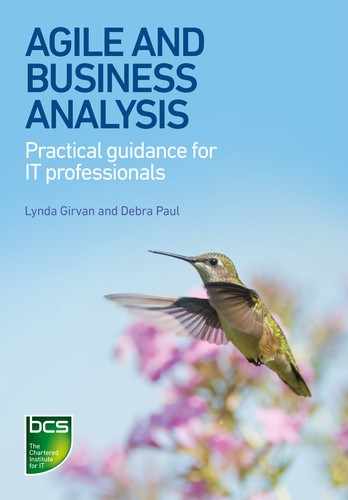Our idea for a book that looked at business analysis from an agile perspective, and agile from a business analysis perspective, arose following many discussions with colleagues and customers. We were concerned that the development of business analysis, and the inroads made in appreciating the benefits it can offer, were in danger of being eroded if agile was adopted by organisations and projects without consideration of the business analysis world view. A review of available publications highlighted that business analysis was not widely explored within agile and the application of agile principles to business analysis (and, conversely, the application of business analysis to agile projects) were not clearly defined anywhere.
Therefore, the topics in this book aim to address this gap and provide comprehensive and practical guidance, enabling business analysts to understand how and when they can support agility at an enterprise, programme and project level. To do this, we needed to provide sufficient details of the agile philosophy, methods and practices plus the relevant business analysis approaches and techniques. The more we considered how these two disciplines would work in combination, the more we felt it was a ‘marriage made in heaven’ that had significant potential to improve information systems activity and outcomes and, consequently, the efficiency and effectiveness of organisations.
In order to provide the coverage we felt necessary, the book forges a path from the origins of agile, through the different levels and aspects of information systems work and, ultimately, looks at how agile might be adopted by an organisation. We felt it was important that all these dimensions were explored if the landscape of business analysis was to be represented thoroughly. Similarly, it was important to encompass the agile world across this landscape.
One of the key aspects we think important, is the need to tailor the approach adopted to information systems work in the light of the organisational context and the scope of the problem to be addressed. Given that agile originated as a software development approach, adapting it to business improvement projects requires careful consideration. Comments made to us about ‘following the Scrum method’ do not align with our world view, which is to always consider the most appropriate way of achieving the desired outcomes that will benefit the enterprise. This is reflected throughout the book as we have described various approaches and techniques in order to support business analysts, and any other IS professionals interested in this topic, in building a toolkit and applying it in an informed way.
The extensive coverage of this book was an ambitious undertaking. As a result, we needed help and support from a number of people. In particular we would like to thank the following two people.
Simon Girvan: Simon is a Fellow of the BCS and a Chartered Engineer, who has over 10 years’ experience working in agile teams in the UK and Australia. He is currently in a technical director role within UK Government, leading several agile teams working on complex bespoke software projects.
Simon’s experience implementing agile principles with non-software projects, and within traditional governance contexts, gives him a perspective on agile development that aligns well with business analysis.
Simon wrote the book sections on estimation, iterations, methods and the history of agile. He was also a reviewer of many chapters and created most of the diagrams used in the book.
Alan Paul: Alan has over 30 years of experience of change programmes and software projects, and has worked in a range of roles including analyst, project manager and technical strategy director.
Alan has worked on projects that have applied various methods and techniques, including structured and agile approaches; this has given him unique insights into the issues that can arise during information system development.
Alan reviewed every chapter in the book and contributed to the sections on analysing the enterprise and estimating.
We were also very fortunate to have colleagues and friends who supported us by reviewing several chapters and suggesting changes to the narrative: Martin Pearson, AssistKD Marketing Director, conducted a thorough and detailed review of several chapters as the book neared completion. James Cadle, AssistKD Director, and Terri Lydiard, Teal Business Solutions Ltd., reviewed the narrative for particular chapters in order to ensure clarity and correctness. Julian Holmes, ThoughtWorks Ltd, worked with us over several meetings to define the initial structure for the book. Carol Christmas undertook a full and thorough review of an early draft of the book.
The BCS publishing team provided ongoing support and encouragement and we would particularly like to thank Ian Borthwick, Becky Youe and Florence Leroy.
This book was a labour of love because we felt it was such an important topic. It required many conversations, coffees and cakes before we felt it offered a valuable contribution to the business analysis and agile domains. We hope all readers will gain insights and useful guidance that will support them in their professional work.
Lynda Girvan
Debra Paul
February 2017
